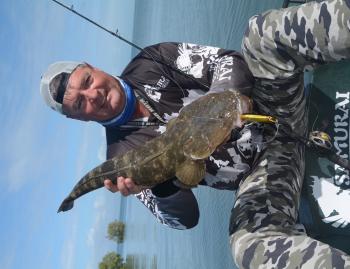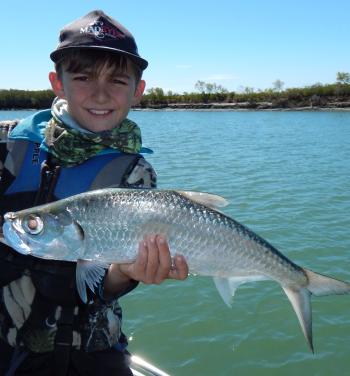Plenty of influencing factors dictate where we fish and how often we get on the water. This year, the biggest influence has been weather. It’s been unfavourable for months on end. The sales in the tackle trade are directly affected by this – if there’s a little window of even one good day, we get smashed. The excitement in anglers’ faces is real.
For the last six weeks now, unstable weather has affected the inshore fishing severely. When you have the wind coming from five different locations in one day, it doesn’t fare well for species like barra and jacks. We watch our resident barra in the tank at work intently, to see how it’s affected, and it’s a pretty good indicator as to what the wild fish are doing. They are seriously influenced by the barometer – he’ll lay sluggishly on the bottom of the tank for days on end, and then suddenly kick into action for a couple hours, or for the day when he wants to feed. These are the days when anglers report good catches, and its no coincidence.
That’s not to say that there’s nothing to catch, and there are rat barra of around 55-60cm still having a go now and then, but it’s a matter of being on the water when they’re going to chew. We hit one snag the other day that had several fish holding in it, and while it took 12 casts to get one over, it was worth the effort. I straighten a hook on a hardbody, and one hook point connected to a fish about 90cm. I had to use lots of thumb to stop him.
We pulled a couple of smaller ones around 55cm and had a couple more roll on the lure. Most of the fish have been found while doing what’s apparently referred to as ‘power fishing’. This basically means covering water and snags pretty quickly, looking for those actively feeding fish and always looking at the sounder to make sure you don’t pass a deeper opportunity. Often, this is how we catch barra. Having rods rigged with several different lure types means that it’s ready to go at the drop of a hat. Interestingly, deeper fish we find on the sounder haven’t always been barra, but more often GTs, bream, tarpon and grunter.
If you’re after big barra, the deeper holes and ledges have been holding a few nice fish. Once you’ve found them, it’s worth flogging the water to foam if you want the bigger fish. In less than 5m, a good way to target them is to tie on a deep diver, like a Poltergeist or Scorpion, cast well past them and retrieve it back slowly around their location. Soft vibes and paddle-tail plastics are sometimes even more effective, as you can subtlety hop right past their noses. When one decides to feed, even for a few minutes, you need to have a lure down there.
Bait fishing has been relatively productive for grunter, bream and your normal bread and butter species, and the prawns have been pretty thick so getting the prime bait hasn’t been too much hassle for those handy with a cast net. Fresh live bait has been more effective on the barra also. The water temperature hasn’t dropped to anywhere near where it was last winter, so the onset of the warmer weather shouldn’t take long to kick some life into the barra.
Don’t forget that the freshwater reaches of the Ross River now require a Stocked Impoundment Permit to fish. Some have their noses out of joint about it, but to be honest, it’s about time. The numbers of barra that can be stocked in the weirs should be much larger now.
There’s also talk about the Ross Dam finally being stocked with barra. In every single location with a stocked impoundment, the local economies have benefitted greatly, so I think it’s a great move for Townsville tourism. I believe that our local council is finally realising that it’s a huge source of revenue being missed for no real reason.
Townsville promotes itself as a fishing tourist destination. Land-based spots that travelling anglers have access to are very limited, and with net free zones either side of us, the commercial sector has been condensed closer to our home waters, with obvious impacts to all. It’s important to remember here, it’s not the pro’s fault, as they’re trying to make a living the same as anyone else. There will always be a need for commercially harvested wild fish, but there has to be a way to do it that’s beneficial to everyone.
The later generations of commercial netters are extremely aware of the issues surrounding the current structure, and some have thrown their efforts behind the stocking of the weirs. Obviously, many barra go over the weirs and into the salt, when we finally have a wet season – a percentage of these find their way into the fish markets, which benefits the commercial sector. There are certainly anglers who genuinely want to help with the stocking of the fresh to support an environment that makes barra fishing easier for recreational anglers.
Some of the pros are working hand in hand with stocking groups to help the cause. This will go a long way in cementing relationships between the two sectors for a beneficial outcome.
Dare I say it, sharks have been insane. While some believe that they’re just becoming more educated, which makes them seem thicker, this doesn’t make sense to me. The number of pup-sized bities at 2-3ft long is phenomenal. I took the young bloke for a flick, at one of our favourite mangrove lines the other day, and caught more sharks on lures than fish. Numbers are getting way out of hand.
If you happen to find a red patch, the only technique to beat them is to go hard on the hook-up, but chances aren’t good. Shallower reefs are another spot for a better chance, until their secret’s discovered. Funnily enough, the further you go out, the less of a problem there is. In less frequented spots, they’re not as conditioned to associate the sound of an outboard with a pending easy feed.
Sinker losses on their own have been quite a considerable expense – reports of up to a hundred bucks worth of lead on a day’s fishing are far from rare. Try using an extra long mono trace between your main line and hook, up to 2m. You’ll find that you get more of your rig back, if you’re having trouble with this.
School macs, doggies and spotties are still about, though not as thick as they were last month. A bit of pellet and fish oil berley may be needed to hold them in your vicinity. The Spanish are plentiful when it’s smooth enough to get our there. All techniques have been working equally at various times, but if you’re trolling a wolfie or gar slowly, it’s worth having a Crazy Deep Scorpion 190 pulse away at the same time. Designed to work at 2-5 knots, they’re the perfect choice to expand your options, until you find what works best.
That’s it for another month. I hope that as the water warms in the next weeks, the wind might back off a bit as well. Then all will be well.
1
There’s a few legal sized fish getting around, and smaller lures like a paddle-tailed shad work well when the barra are feeding on small bait. Tannhym pulled this one while working a rock bar in 3m of water.
2
This chromed-up barra was caught while chasing the run in tide. This is a great time for the hardbodies and small shads in the shallows.
3
You just never know what to expect in the drains and creek mouths, and this flatty took a 120 Laser Pro twitched in water as the tide built.
4
Though not as thick as they were in past weeks, mackerel are still here and show up in unexpected locations. This one took a Halco Paddle Prawn while fishing for other species. Made from RST material, the Paddle Prawns hold up well to teeth.
5
There are still a few jacks around, but nowhere near as thick as they were weeks ago. This will change over the next few weeks.
6
Cooler water often requires a subtle approach, and small lures like this little paddle-tail Atomic work well.
7
When you see activity in the middle of the river, it's worth having a cast. Anglers love tarpon, and at this size, they’re a handful on the light gear.
8
The wolfies are thick at present, and are way up in the creeks harassing bait schools.
Reads: 2072











